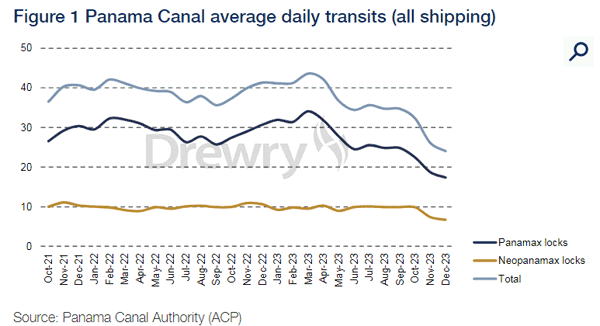As has been widely reported, the Panama Canal Authority has recently reduced the daily maximum of ship transits through the Canal from 36 per day to 24, starting in January.
Supply Chain Digest Says... |
 |
|
| Drewry says "it seems that for containerships at least, the Panama Canal bottleneck is proving much less restrictive than it might otherwise have been.” |
|
 |
|
What do you say? |
|
| Click here to send us your comments |
|
| |
|
| Click here to see reader feedback |
|
|
|
On December 15, 2023, the Canal reversed an earlier decision to reduce the number of daily transits for a second time. Rather than dropping to 20 transit slots in January and 18 in February, the ACP instead increased the number of transits to 24 per day on January 1 2024, from 22. This is still a long way down from the 35-40+ daily transits seen before restrictions were imposed last year.
The cause: severe drought conditions that have reduced water levels in Gatun Lake, which is not only used to operate the locks but also to provide drinking water to the Panamanian people.
Experts cite higher than usual temperatures in the Atlantic Ocean, along with a strong El Niño phenomenon and a delayed rainy season as the reasons behind why there are fewer ships able to use the canal and why some are being forced to lower cargo weight in transit.
The maritime analysts at Drewry recently took a look at the impact in a recent blog post.
Drewry says that monthly data from the Panama Canal Authority (ACP) shows that while the total number of transits across all commercial shipping sectors is declining, container ships are increasing their share as other shipping sectors are increasingly redirecting ships to other rouses.
This has enabled container ships to come close to maintaining their daily average of transit seen in recent years.
That as the overall decline in transits has been significant. (See graphic below.)

Source: Drewry
The Canal Authority’s data for December shows that monthly transits (in both locks) were down by about 25% compared to October 2023, making it only 746 transits versus 1,002 the previous year. In December 2022, there were 1,281 transits, so the latest figures represent a 42% year-over-year decline.
(See More Below)
|
CATEGORY SPONSOR: SOFTEON |
|
|
|
|
|
Drewry observes that currently ships transiting Panama’s Neopanamax locks are allowed maximum drafts of up to 44 feet (versus a 50-foot max in normal conditions), while vessels transiting the Panamax locks have no draft limitations from the normal 39.5-foot cap.
It is estimated that container ships lose approximately 350 teu capacity for every foot of lost draft. For the biggest container ships able to sail through the Neopanamax locks this could reduce the payload by around 2,000 teu.
Drewry adds that “Container ships have mostly avoided the long queues outside the Panama Canal and the hugely expensive transit auctions by use of a pre-booking system.
“Effectively, containerships are finding it easier to reserve slots as some other sectors (most obviously dry bulk) continue to vacate the route,” Drewry notes."'
In conclusion, Drewry notes that “The situation is obviously very fluid and further draft restrictions could be announced at any time, but it seems that for containerships at least, the Panama Canal bottleneck is proving much less restrictive than it might otherwise have been.”
What are your thoughts on the Panama Canal situation? Let us know your thoughts at the Feedback section below.
Your Comments/Feedback
|

